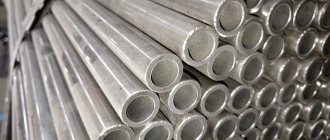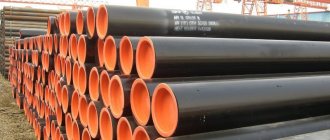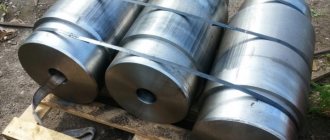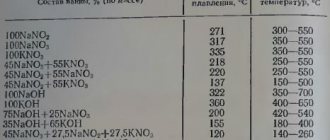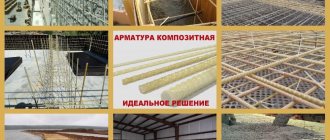The alloy, which is characterized by ease of use, ease of processing, good strength and hardness, as well as low cost, can confidently be called universal, applicable in any conditions. Steel 20 is not a specialized steel; on the contrary, its application possibilities are so wide that it has found a place in almost every industrial sector.
Detailed information on the supply of sheet steel and a price calculator can be found on our website.
Total information
Steel 20 is a structural carbon quality steel widely used in industry. Its popularity is not inferior to 09G2S steel, although in terms of technical and operational characteristics there is a noticeable difference between these grades. Steel 20 is used mainly for the production of parts, welded structures, in construction, and mechanical engineering, but a complete list of industries for its use would take several pages of text. The practicality of steel of this grade allows it to occupy one of the leading positions on the market among ferrous rolled metals.
Characteristics
The metal is characterized by excellent weldability; there are no special requirements for welding, except in cases where the parts have previously been subjected to chemical or heat treatment. Steel 20 is not prone to temper brittleness and is insensitive to flakes and flake sensitivity. The alloy is resistant to pressure treatment, can be cut well by any means, does not crack, and is amenable to surface machining.
Steel 20 is less resistant to chemical attack; contact with alkalis and acids is not recommended. There is no protection against corrosion; products made from steel 20 are not recommended for use in conditions of high humidity, in contact with water without additional protective coatings (zinc, chrome or paint).
Heat treatment of steel 40Х
Heat treatment of steel 40X - alloy structural steel is intended for high-strength parts such as axles, shafts, gear shafts, plungers, rods, crank and cam shafts, rings, spindles, mandrels, racks, sponge rings, bolts, axle shafts, bushings and other parts increased strength. 40X steel is also often used to produce forgings, stampings and pipe fittings. However, the last listed parts require additional heat treatment, which consists of quenching through water in oil or simply in oil, followed by tempering in oil or air.
Decoding steel grade 40X. The number 40 indicates that the steel contains 0.4% carbon. Chromium content is less than 1.5%. In addition to the usual impurities, it contains specially introduced elements in certain quantities, which are designed to provide specially specified properties. In this case, chromium is used as an alloying element, as indicated by the corresponding marking.
Heat treatment of steel 20
Heat treatment of steel 20 - high-quality structural carbon steel. Widely used in boiler making, for pipes and heating pipelines for various purposes; in addition, the industry produces rods and sheets. The starting temperature for forging steel 20 is 1280° C, the end temperature is 750° C, the forging is cooled by air. Steel 20 is non-flock sensitive and not prone to tempering. After carburization and cyanidation, steel 20 can be used to produce parts that require high surface hardness and can tolerate low core strength: cam rollers, fasteners, spindles, sprockets, studs, link forks and shift shafts gears, valve tappets, oil pump rollers. Steel 20 is used for the production of lightly loaded parts (pins, axles, copiers, stops, gears), cemented parts for long and very long service (operation at temperatures not exceeding 350 ° C), thin parts exposed to abrasion and other parts of automotive and agricultural mechanical engineering.
Heat treatment of steel 30khgsa
Heat treatment of steel 30xgsa - refers to medium-alloy structural steel. Steel 30xgsa undergoes improvement - hardening followed by high tempering at 550-600 ° C, therefore it is used in the creation of improved parts (except for aircraft parts, these can be various casings, axles and shafts, blades of compressor machines that operate at 400 ° C, and much more), levers, pushers, critical welded structures operating under alternating loads, fasteners operating at low temperatures. Steel 30xgsa has good endurance, excellent impact strength, and high strength. It also has excellent weldability.
Welding 30xgsa steel also has its own characteristics. It is carried out with preheating of the material to 250-300 ° C, followed by slow cooling. This procedure is very important because cracks may appear due to the sensitivity of the steel to sudden temperature changes after welding. Therefore, upon completion of welding work, the torch should be withdrawn slowly, while heating the material at a distance of 20-40 mm from the welding site. Also, no more than 8 hours after completion of welding, welded joints of 30KhGSA steel require quenching with heating to 880 °C, followed by high tempering. Next, the product is cooled in oil at 20-50 °C. Tempering is carried out by heating to 400 - 600 ° C and cooling in hot water. Welding must be performed as quickly as possible in order to avoid burnout of alloying elements. After undergoing thermomechanical low-temperature treatment, 30KhGSA steel acquires a tensile strength of up to 2800 MPa, impact strength doubles (in contrast to conventional heat treatment of 30KhGSA steel), and ductility increases.
Heat treatment of steel 65g
Heat treatment of steel 65g - Structural spring steel. Springs, leaf springs, thrust washers, brake bands, friction discs, gears, flanges, bearing housings, clamping and feed collets and other parts that require increased wear resistance and parts that operate without shock loads are used in industry. (substitutes: 70, U8A, 70G, 60S2A, 9HS, 50HFA, 60S2, 55S2).
Heat treatment of steel 40 - High-quality carbon structural steel. Industrial use: pipes, forgings, fasteners, shafts, discs, rotors, flanges, gears, bushings for long and very long service at temperatures up to 425 degrees.
Heat treatment of steel 40xn - Structural alloy steel Use in industry: axles, shafts, connecting rods, gears, excavator shafts, couplings, gear shafts, spindles, bolts, levers, rods, cylinders and other critical loaded parts subject to vibration and dynamic loads , which are subject to requirements for increased strength and toughness. Rolls of rail and beam and large-section mills for hot rolling of metal.
Heat treatment of steel 35 - High-quality carbon structural steel. Use in industry: parts of low strength that experience low stress: axles, cylinders, crankshafts, connecting rods, spindles, sprockets, rods, rims, traverses, shafts, tires, discs and other parts.
Heat treatment of steel 20Х13 - Corrosion-resistant, heat-resistant steel. Use in industry: power engineering and furnace making; turbine blades, bolts, nuts, fittings for cracking units with a long service life at temperatures up to 500 degrees; martensitic class steel Steel grade 20Х13 and other martensitic class steels: heat-resistant martensitic chromium steels are used in various power plants; they operate at temperatures up to 600° C. Rotors, disks and turbine blades are made from them, and recently they have been used for ring parts large thicknesses. There are a large number of steel grades of this class. Common to all is a reduced chromium content, the presence of molybdenum, vanadium and tungsten. They are effectively strengthened by conventional heat treatment methods, which are based on the y-a transformation and provide for the formation of martensite in the structure with subsequent improvement depending on the technical requirements. (substitutes: 12Х13, 14Х17Н2)
Advantages and disadvantages of steel 20
Steel 20 is distinguished by its quality and relatively low production cost. It is an upgradeable alloy, making it adaptable to a wide range of conditions and, as a result, widespread.
Steel 20 is corrosion-resistant and susceptible to chemical influences - this is its main drawback. The advantages include:
- good weldability without special requirements for the procedure;
- disinclination to temper fragility;
- insensitivity to flakes;
- price-quality ratio;
- material density;
- moderate strength.
Steel 20 is a ferrous metal with a simple composition without expensive alloying additives. The alloy has been produced for a long time, the production process is well studied, optimized, and worked out; There are no special conditions or requirements, so the metal is not very expensive.
Production process
Optimization of the production of pearlitic steels is associated with the search for the best combinations of alloying elements: as we know, there should not be many of them, so the research is thorough.
In particular, to improve rolling, the maximum percentage of vanadium and silicon, elements that increase the performance characteristics of these steels, is regulated.
The results of mechanical tests show that such alloying additives have a beneficial effect on the mechanical properties of steels, especially those related to tensile strength. Silicon strengthens pearlite, mainly due to solid solution strengthening of the ferrite phase. Vanadium increases the strength of pearlite, mainly due to dispersion strengthening of pearlite ferrite. When added individually, these elements provide relatively greater strengthening at higher transformation temperatures. When added in combination (vanadium + silicon), the behavior is different and a significant increase in strength is achieved at all transformation temperatures studied (from 550°C to 650°C).
Explanation of markings
The marking of steel 20 indicates the chemical composition of the alloy, in particular; on the proportion of carbon in the composition. Since 20 steel is considered high quality, higher demands are placed on the accuracy of its chemical composition.
Chemical composition
The chemical composition of steel 20 includes the following elements and their designations:
- Carbon. The first digit 20 indicates the carbon content in hundredths, i.e. 0.2%. The advantage of steel with a high carbon content is higher strength, but this same indicator leads to a decrease in ductility.
- Silicon. The proportion of silicon in the alloy ranges from 0.17 to 0.35%. Due to the presence of silicon in the metal composition, porosity and the number of gas pockets, which negatively affect the strength of the alloy, are reduced. Pores and cavities are formed due to oxygen, nitrogen and hydrogen gases, the particles of which are removed by silicon.
- Manganese. The proportion of manganese ranges from 0.35 to 0.6%. Manganese, like silicon, prevents oxidation and also removes sulfur from the composition. Thanks to manganese, heat treatment under pressure occurs with a low probability of crack formation, the effectiveness of forging and welding works improves, and the surface of products becomes of higher quality.
- Chrome, copper, nickel. The proportion of nickel and copper usually does not exceed 0.3%, the proportion of chromium; 0.2%. These are alloying additives that have a positive effect on the properties of steel, but in this case their content is insignificant, so they do not have a noticeable effect on the characteristics of the alloy.
- Phosphorus, sulfur. Phosphorus content is permissible up to 0.035%, sulfur; up to 0.04%. These are impurities that have a harmful effect on steel. They increase brittleness and negatively affect toughness, as a result of which the steel loses its resistance to dynamic loads.
- Iron. The rest of the alloy is iron.
Chemical composition in % of material 20
| C | Si | Mn | Ni | S | P | Cr | Cu | As |
| 0.17 — 0.24 | 0.17 — 0.37 | 0.35 — 0.65 | up to 0.3 | up to 0.04 | up to 0.035 | up to 0.25 | up to 0.3 | up to 0.08 |
GOST 1050-88
Description of pearlitic steels
Pearlite is formed by fairly slow cooling in the iron-carbon system at the eutectoid point on the Fe-C phase diagram (723°C, eutectoid temperature). In a pure Fe-C alloy, it contains about 88 volume percent ferrite and 12 volume percent cementite. Pearlite is known for its viscosity, and in a highly deformed state, for its very high strength.
When examined under a microscope, pearlite has a characteristic appearance created by thin lamellar stripes. It resembles nacre, a natural plate-like structure found in some species of molluscs. However, it does not follow from this that perlite is created through the natural deposition of successive layers. It is formed as a result of special processing of the eutectoid mixture, separating the hardness and strength indicators.
Pearlite is a product of the decomposition of austenite as a result of a eutectoid reaction, therefore all steels of the class under consideration are characterized by a lamellar arrangement of ferrite and cementite. Pearlite grows as nodules at the boundaries of preexisting austenite, so each nodule may have a different colony or orientation. These nodules may propagate to cover the preceding austenite boundaries. By changing the reaction temperature, the distance or length scale of any pearlitic grade steel can be changed by cementite branching.
Types of rental
There are two main technologies for producing rolled profiles from steel 20:
- Hot deformation - used for rolling workpieces more than 4 mm thick. Hot deformation leads to the formation of scale, which is the main disadvantage of this technology.
- Cold deformation; used for rolling thin workpieces (up to 4 mm). As a result of cold deformation, the strength of the alloy increases due to cold hardening.
Types of steel products 20
- profile of all varieties: channel, sheet, I-beam, angle, rod, wire;
- seamless, high-strength pipes obtained by drawing (cold or hot);
- all-welded cold-rolled pipes, welded from a single sheet of steel 20 along the length of the pipe.
Production Standards
- long products, including shaped steel - GOST 1050-88, GOST 2590-2006, GOST 2591-2006, GOST 2879-2006, GOST 8509-93, GOST 8510-86, GOST 8240-97, GOST 8239-89;
- calibrated rod - GOST 7417-75, GOST 8559-75, GOST 8560-78, GOST 10702-78;
- polished rod and silver - GOST 14955-77;
- thick sheet - GOST 1577-93, GOST 19903-74;
- thin sheet - GOST 16523-97;
- tape - GOST 6009-74, GOST 10234-77, GOST 103-2006, GOST 82-70;
- wire - GOST 5663-79, GOST 17305-91;
- forgings and forged blanks - GOST 8479-70;
- pipes - GOST 10704-91, GOST 10705-80, GOST 8731-74, GOST 8732-78, GOST 8733-74, GOST 5654-76, GOST 550-75.
Purpose and application
Steel 20 is one of the most common steel grades in the domestic industry; its versatility allows the production of almost all types of metal products. The main areas of application of steel 20:
- Mechanical engineering. Steel 20 is used to make fastening devices, connecting elements of mechanisms, gears, worms, brackets, bearing shafts, and liners.
- Pipelines. Steel 20 is used to make welded and seamless pipes, shut-off valves and adapters; crosspieces, union nuts, nipples, fittings, hexagons, couplings, taps, manifolds, superheaters, parts of boilers operating under high pressure.
- Construction. Fasteners, hooks, load-bearing trusses, beams and much more. In construction, steel 20 is popular due to its good weldability, satisfactory strength and availability.
Three types of steel 20 according to deoxidation level
Deoxidation is the removal of oxygen from the composition of steel 20 in order to reduce the brittleness during hot working. The degree or level of deoxidation can also be called the degree of gas evolution during steel solidification. The intensity of gas evolution or boiling greatly affects the structure of the frozen metal; accordingly, the higher the level of deoxidation, the more solid and durable the structure will be.
Quiet and semi-quiet steel
Steel, which is deoxidized by silicon and manganese, can be maximally purified of oxygen content. Such steel is characterized by a complete structure without bubbles and pores, because the alloy solidifies in a calm state, without active release of gases. The formation of a shrinkage cavity occurs in the upper part; it is removed mechanically.
Quiet steel is more expensive than boiling and semi-quiet steel, because more difficult to produce. It is used in the manufacture of products with high strength requirements, for example, for load-bearing structures, railway tracks, etc.
Semi-quiet steel; an average state between calm and boiling steel, characterized by medium porosity. It comes in different qualities and is used for the manufacture of welded structures, blanks for rolled pipes, and fasteners.
Calm steel has the highest levels of strength and reliability, but its use may not be economically viable in industries where high demands are not placed on steel products.
Boiling steel
Steel 20, the deoxidation process of which is carried out thanks to manganese, contains the largest amount of dissolved gases and iron oxides. When boiling steel hardens, nitrogen and carbon dioxide are actively released, and multiple bubbles and pores are formed. Such steel is inferior to calm and semi-quiet steel in terms of strength, but has a number of positive characteristics. It is perfectly stamped, the process of its production is simpler and cheaper, and the production is waste-free.
Boiling steel is suitable for the production of products that are not subject to high loads during operation. This can be various types of fencing, sheet cladding, and other metal structures.
Welding Features
Welding pearlitic steels, regardless of the method, usually does not encounter any difficulties. During welding, local melting occurs, re-solidification and subsequent cooling to room temperature.
The microstructure in the heat-affected zone includes a central melt region with austenite, which is obtained by local heating of pearlite. Provided that the weld is cooled slowly enough to room temperature, pearlite will form in the weld area. It may have a different grain size than the original material, but will have similar properties. At an increased cooling rate, the equilibrium phase transition does not occur, so martensite is formed from austenite in the melt zone. As a result, the weld becomes hard and brittle, which is undesirable for the mechanical connection of parts. To avoid this situation, the cooling rate is usually reduced or the weld is heat treated (tempered).
Mechanical properties
Steel 20 is characterized by high mechanical properties, such as ductility, hardness and strength. The high impact strength allows the steel to adequately withstand increased dynamic loads. Strength is improved by thermal or mechanical treatments - peening, roller rolling, annealing, normalization.
The specific gravity of steel is 7.85 g/cm3. Maximum linear expansion coefficient st 20 = 14.8·10-6 deg-1 at temperatures 27-700°C. Indicators for calibrated hot-rolled steel of the 2nd category: temporary tensile strength 410 MPa, relative elongation after fracture 25%, relative contraction 55%, Brinell hardness 4.8.
Mechanical properties at T=20oC of the material 20.
| Assortment | Size | Eg. | s in | s T | d5 | y | KCU | Thermal change |
| — | mm | — | MPa | MPa | % | % | kJ/m2 | — |
| Heat treated sheet, GOST 4041-71 | 4 — 14 | 340-490 | 28 | |||||
| Hot-deformed pipes, GOST 550-75 | 431 | 255 | 22 | 50 | 780 | |||
| Pipes, GOST 8731-87 | 412 | 245 | 21 | |||||
| Pipes, GOST 10705-80 | 372 | 225 | 22 | |||||
| Rolled products, GOST 1050-88 | up to 80 | 410 | 245 | 25 | 55 | Normalization | ||
| Rolled products cold-hardened, GOST 1050-88 | 490 | 7 | 40 | |||||
| Rolled products annealed, GOST 1050-88 | 390 | 21 | 50 | |||||
| Annealed tape, GOST 2284-79 | 310-540 | 18 | ||||||
| Cold-worked tape, GOST 2284-79 | 490-830 |
Mechanical properties of steel 20 at elevated temperatures 0С
| Temperature tests, °C | σ 0.2, MPa | σ V, MPa | δ5, % | ψ, % | KCU, J/cm2 |
| 20 | 280 | 430 | 34 | 67 | 218 |
| 200 | 230 | 405 | 28 | 67 | 186 |
| 300 | 170 | 415 | 29 | 64 | 188 |
| 400 | 150 | 340 | 39 | 81 | 100 |
| 500 | 140 | 245 | 40 | 86 | 88 |
| 700 | 130 | 39 | 94 | ||
| 800 | 89 | 51 | 96 | ||
| 900 | 75 | 55 | 100 | ||
| 1000 | 47 | 63 | 100 | ||
| 1100 | 30 | 59 | 100 | ||
| 1200 | 20 | 64 | 100 |
Steel endurance limits 20
| σ -1 , MPa | J -1 , MPa | n | δ5 , MPa | σ 0.2 ,MPa | Heat treatment, steel condition |
| 206 | 1E+7 | 500 | 320 | ||
| 245 | 520 | 310 | |||
| 225 | 490 | 280 | |||
| 205 | 127 | Normalization 910 C, release 620 C. | |||
| 193 | 420 | 280 | |||
| 255 | 451 | Cementation 930 C, hardening 810 C, tempering 190 C. |
Mechanical properties of steel 20 after chemical treatment
| Section, mm | σ 0.2 , MPa | σ V , MPa | δ5, % | y, % | KCU, J/m 2 | HB | H.R.C. |
| Cementation 920-950 °C, air. Quenching 800-820 °C, water. Vacation 180-200 °C, air. | |||||||
| 50 | 290-340 | 490-590 | 18 | 45 | 54 | 156 | 55-63 |
| Temperature of critical points, °C | |||
| Ac1 | Ac3 | Ar1 | Ar3 |
| 735 | 850 | 680 | 835 |
Alloyed alloy 20x23n18
If it is necessary to manufacture parts for special or universal purposes, production steel is alloyed with additional components.
Alloyed impurities (nickel, copper, chromium, tungsten, cobalt), added in a certain amount, impart characteristic properties to the alloy.
Chromium gives the material increased mechanical hardness and strength, while reducing its ductility, as well as heat resistance and corrosion resistance properties. Nickel makes alloys more ductile and durable.
The added components have a high percentage in the structure of the alloy and indicate its mechanical and technical characteristics. The doping level is high.
The alloy belongs to the austenitic class and has a tendency to form hot deformations in the form of cracks. This limits the weldability of the metal. The technology for welding steel 20x23n18 is carried out using TIG, PA or electrode. You can use a filler metal having the same composition.
Technological properties
Steel 20 is a high-tech alloy classified as cemented. The cementation process is the saturation of the surface of a product with carbon by heating in a special environment. As a result of this treatment, the top layer of the product acquires a hardness value of up to 62 HRC, which is three times higher than that of the core. The metal lends itself well to forging, cutting and soldering, is not prone to cracking, and retains high density. All popular methods are applicable for welding - ADS, KTS, RDS, submerged arc welding, etc. The type of equipment depends on the selected welding technology.
| Forging | Forging temperature, °C: beginning 1280, end 750. Cooling in air. |
| Weldability | Weldable without restrictions, except for parts after chemical-thermal treatment. Welding methods: manual arc welding, automatic arc welding, resistance welding. |
| Machinability | In the hot-rolled state at HB 126-131 and σв= 450-490 MPa: Kv hard alloy= 1.7 Kv high-speed steel= 1.6 |
| Flokensensibility. | Not sensitive |
| Tendency to temper brittleness | Not inclined |
Impact strength of steel 20 KCU (J/cm3) at low temperatures °C
| Compliance with GOST | Type of delivery | Section, mm | KCU at +20 | KCU at -40 | KCU at -60 |
| 19281-73 | Long and shaped rolled products | from 5 to 10 | 64 | 39 | 34 |
| from 10 to 20 incl. | 59 | 34 | 29 | ||
| from 20 to 100 incl. | 59 | 34 | — |
Steel yield strength 20
| Test temperature, °C/s0,2 | |||||||
| 150 | 200 | 250 | 300 | 320 | 350 | 400 | 450 |
| ≥215 | ≥210 | ≥196 | ≥180 | ≥160 | ≥137 | ≥127 | |
Hardness
| Hardness 20 after annealing, GOST 1050-88 | HB 10-1= 163 MPa |
| Hardness 20 calibrated cold-worked, GOST 1050-88 | HB 10-1= 207 MPa |
| Hardness 20, Heat treated sheet. GOST 4041-71 | HB 10-1= 127 MPa |
| Hardness 20, Hot deformed pipes. GOST 550-75 | HB 10-1= 156 MPa |
| Hardness 20, Pipes GOST 8731-87 | HB 10-1= 156 MPa |
| Hardness 20, Thick sheet annealed. GOST 1577-93 | HB 10-1= 156 MPa |
Classification
According to the accepted terminology, it is recommended to classify pearlitic steels according to the percentage of carbon they contain. Under the condition of equilibrium microstructure (meaning slow cooling, which excludes the formation of cementite Fe3C), steels are distinguished:
- Hypoeutectoid
- Eutectoid
- Hypereutectoid.
As already noted, hypoeutectoid steels contain no more than 0.6% carbon, and hypereutectoid steels contain more than 0.6...0.8%. In hypoeutectoid steels, the equilibrium microstructure at room temperature consists of ferrite and pearlite; this ferrite is called hypoeutectoid ferrite. Cooling from austenite (in the range from 875°C to 775°C) and further cooling to room temperature gives a microstructure consisting of hypoeutectoid ferrite and pearlite (isothermal transformation occurs at 727°C when austenite reaches eutectoid composition).
When the temperature drops below the eutectoid line (727°C), all austenite is converted to pearlite, with virtually no change in the hypoeutectoid ferrite structure produced during cooling. Proeutectoid ferrite is present as a continuous matrix phase surrounding isolated pearlite colonies. Ferrite is also present in pearlite and is known as eutectoid ferrite, which appears white in micrographs. The dark appearance of perlite is explained by the narrow composition of the microcomponents present in it.
Steel containing 0.8% C is known as eutectoid. The equilibrium microstructure obtained at room temperature is pearlite, which in turn is a mixture of ferrite and cementite. Ferrite is a very soft component and cementite is a very hard component of steel. This microstructure is obtained by equilibrium cooling from 800°C and has a lamellar structure.
The thick layers in the pearlite grain represent the ferrite phase, and the cementite phase appears as thin dark plates.
Pearlite has properties intermediate between soft plastic ferrite and hard brittle cementite. In hypereutectoid steel, the equilibrium microstructure at room temperature contains hypoeutectoid cementite and pearlite. The main difference from the hypoeutectoid structure is that there is a continuous network of cementite that separates each pearlite colony. As the carbon content increases, the thickness of the cementite network increases.
Physical properties
The melting point of steel 20 is 1500C, steel becomes liquid at 1600C. Steel 20 has good thermal conductivity and heat capacity. The modulus of elasticity, coefficient of thermal expansion, thermal conductivity, density, specific heat capacity and electrical resistivity for various temperatures are shown in the table below.
Physical properties of the material 20 .
| T | E 10- 5 | a106 | l | r | C | R 109 |
| hail | MPa | 1/Grad | W/(m deg) | kg/m3 | J/(kg deg) | Ohm m |
| 20 | 2.13 | 52 | 7859 | |||
| 100 | 2.03 | 11.6 | 50.6 | 7834 | 486 | 219 |
| 200 | 1.99 | 12.6 | 48.6 | 7803 | 498 | 292 |
| 300 | 1.9 | 13.1 | 46.2 | 7770 | 514 | 381 |
| 400 | 1.82 | 13.6 | 42.8 | 7736 | 533 | 487 |
| 500 | 1.72 | 14.1 | 39.1 | 7699 | 555 | 601 |
| 600 | 1.6 | 14.6 | 35.8 | 7659 | 584 | 758 |
| 700 | 14.8 | 32 | 7617 | 636 | 925 | |
| 800 | 12.9 | 7624 | 703 | 1094 | ||
| 900 | 7600 | 703 | 1135 | |||
| 1000 | 695 | |||||
| T | E 10- 5 | a106 | l | r | C | R 109 |
